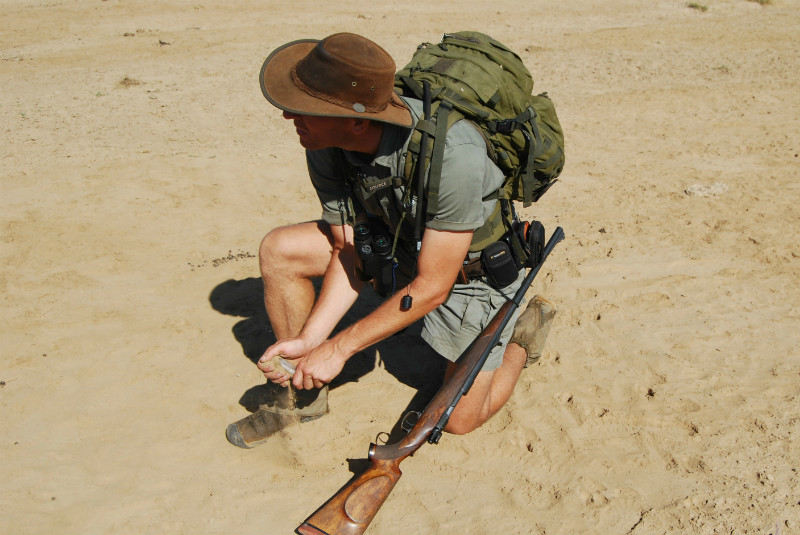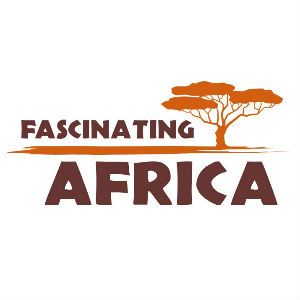As a trails guide it wasn’t just a rifle that I took out each day. There was also a big backpack that I strapped on each morning when I headed into the bush. Here’s a photo list of what was in the bag and a brief summary of why it was there.
I had a couple of laminated cards which were always handy during the training but once I was qualified the guest check and the pre-walk brief just rolled off the tongue.
The guest check was usually delivered the night before the morning walk, it was designed to prepare the guests for the walk the next morning so that they knew what to expect and the turned up properly prepared.
The second card, the pre-walk brief was delivered as we were about to set off. This was to brief the guests on the five important rules as well as the necessary hand signals for when walking in silence.
Probably the most important piece of kit for approaching dangerous game on foot. It’s a small make-up bottle which is full of fine dust or ash.
Periodically whilst on trail I would produce this and give it a quick squirt. The dust or ash would indicate the direction of the wind, it’s invaluable to know which way my scent would be blown at all times.
There are many ways that this can be done, some people fill an old sock with ash (ensure the ash is not still a light!) but the more experienced will simply know by how the wind falls on their face.
Pair of binoculars with rigging for attaching to the chest straps of the backpack to take the weight off the neck.
Portable rifle cleaning kit. Cut off toothbrush for dusting down the outside and inside of the rifle. Trisol and 2 x 2 clothes for oiling the weapon and a bore snake / pull through for cleaning the barrel.
This last piece of equipment is my favourite. It makes the job so much easier back at camp, far better than messing around with rods and bits.
GPS, not essential but a good bit of kit. Not just for finding where you left the Landy but for finding previous marked waypoints such as rock paintings, hyena dens etc. It was also great for recording data such as km walked and time elapsed on trail. Spare batteries in the belt pouch.
Poncho, not something I carried in my bag on every trail, if we were just out for the morning or a day and it rained I simply got wet.
However, if I were out over night then it was worthwhile taking. Once on an overnighter it rained for a good part of the trail including the night.
The poncho worn conventionally during the day meant I remained fairly dry and the then at night I rigged it up with some paracord to keep the rain off my face whilst I (tried to) slept.
Another piece of essential equipment, the Leatherman (multi-tool). Used for everything from measuring a track to tightening a screw on the rifle and from fashioning a toothbrush out of a twig to cutting the wire of a snare.
And of course, not forgetting the many running repairs required of operating a Landrover in the bush environment. There wasn’t a day that didn’t require this versatile tool.
A hunting knife, but in my case not for hunting. Many other uses for this solidly built knife. I’ve used it for splitting logs, digging, whittling and opening up animals for the vulture when we have had to destroy them due to injuries sustained from poaching.
Having the knife attached to the base of my backpack (it was too big for my belt as I don’t have the thighs of Rambo) meant for easy access should I need it quickly as a last resort. Or that’s what they suggest in the manuals but I’m no Tarzan either.
The GPS isn’t essential but the compass is. It doesn’t need batteries and was always there if I needed to know which way home was.
Three litre camel back, perfect for taking on water frequently throughout the trail. Keeping hydrated kept me alert and fresh. As a trails guide I would also carry 500 ml of water per guest as an emergency supply (ideally I would share the burden with my partner for the walk).
CPR mouth guard and rubber gloves for medical treatment.
Emergency whistle – can be used when lost or for frightening off dangerous game.
Head torch – I wouldn’t leave camp without it, you never know how long you’ll be out on trail especially if there is a drive and sundowners involved. It gets dark incredibly quickly in Africa.
Paracord – I certainly had more than this in my pack, just shows how often it was used that there is only a little left. A 1001 uses.
There’s also a two way radio, first aid kit, basic survival kit and possibly some snack food such as rusks
Get involved
Get a full understanding of what a field guide / safari guide by visiting our definitive guide to the Safari Guide.
Awaken your primeval instinct by trying out one of the Afrcan wildlife courses we have on offer.
















 Previous Post
Previous Post
